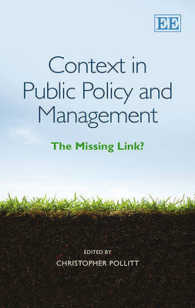- ホーム
- > 洋書
- > 英文書
- > Science / Mathematics
Full Description
This book is ideal for a one-semester course in statistics, offering a streamlined presentation of Introductory Statistics: Exploring the World through Data, by Gould/Ryan.
Exploring the World through Data
We live in a data-driven world, and the goal of this text is to teach students how to access and analyze these data critically. Authors Rob Gould, Colleen Ryan, and Rebecca Wong want students to develop a "data habit of mind" because learning statistics is an essential life skill that extends beyond the classroom.and Regardless of their math backgrounds, students will learn how to think about data and how to reason using data. With a clear, unintimidating writing style and carefully chosen pedagogy, this text makes data analysis accessible to all students.
Also available with MyStatLab
MyStatLab™ from Pearson is the world's leading online resource for teaching and learning statistics, integrating interactive homework, assessment, and media in a flexible, easy-to-use format. MyStatLab is a course management system that delivers improving results in helping individual students succeed.
Note: You are purchasing a standalone product; MyLab™ & Mastering™ does not come packaged with this content. Students, if interested in purchasing this title with MyLab & Mastering, ask your instructor for the correct package ISBN and Course ID. Instructors, contact your Pearson representative for more information.
If you would like to purchase boththe physical text and MyLab & Mastering, search for:
0134466012 / 9780134466019 Essential Statistics Plus MyStatLab with Pearson eText -- Access Card Package
Package consists of:
0134134400 / 9780134134406 Essential Statistics
0321847997 / 9780321847997 My StatLab Glue-in Access Card
032184839X / 9780321848390 MyStatLab Inside Sticker for Glue-In Packages
Contents
Preface
Index of Applications
1. Introduction to Data
Case Study-Deadly Cell Phones?
1.1 What Are Data?
1.2 Classifying and Storing Data
1.3 Organizing Categorical Data
1.4 Collecting Data to Understand Causality
Exploring Statistics-Collecting a Table of Different Kinds of Data
2. Picturing Variation with Graphs
Case Study-Student-to-Teacher Ratio at Colleges
2.1 Visualizing Variation in Numerical Data
2.2 Summarizing Important Features of a Numerical Distribution
2.3 Visualizing Variation in Categorical Variables
2.4 Summarizing Categorical Distributions
2.5 Interpreting Graphs
Exploring Statistics-Personal Distance
3. Numerical Summaries of Center and Variation
Case Study-Living in a Risky World
3.1 Summaries for Symmetric Distributions
3.2 What's Unusual? The Empirical Rule and z-Scores
3.3 Summaries for Skewed Distributions
3.4 Comparing Measures of Center
3.5 Using Boxplots for Displaying Summaries
Exploring Statistics-Does Reaction Distance Depend on Gender?
4. Regression Analysis: Exploring Associations between Variables
Case Study-Catching Meter Thieves
4.1 Visualizing Variability with a Scatterplot
4.2 Measuring Strength of Association with Correlation
4.3 Modeling Linear Trends
4.4 Evaluating the Linear Model
Exploring Statistics-Guessing the Age of Famous People
5. Modeling Variation with Probability
Case Study-SIDS or Murder?
5.1 What Is Randomness?
5.2 Finding Theoretical Probabilities
5.3 Associations in Categorical Variables
5.4 Finding Empirical Probabilities
Exploring Statistics-Let's Make a Deal: Stay or Switch?
6. Modeling Random Events: The Normal and Binomial Models
Case Study-You Sometimes Get More Than You Pay For
6.1 Probability Distributions Are Models of Random Experiments
6.2 The Normal Model
6.3 The Binomial Model (optional)
Exploring Statistics-ESP with Coin Flipping
7. Survey Sampling and Inference
Case Study-Spring Break Fever: Just What the Doctors Ordered?
7.1 Learning about the World through Surveys
7.2 Measuring the Quality of a Survey
7.3 The Central Limit Theorem for Sample Proportions
7.4 Estimating the Population Proportion with Confidence Intervals
7.5 Comparing Two Population Proportions with Confidence
Exploring Statistics-Simple Random Sampling Prevents Bias
8. Hypothesis Testing for Population Proportions
Case Study-Dodging the Question
8.1 The Essential Ingredients of Hypothesis Testing
8.2 Hypothesis Testing in Four Steps
8.3 Hypothesis Tests in Detail
8.4 Comparing Proportions from Two Populations
Exploring Statistics-Identifying Flavors of Gum through Smell
9. Inferring Population Means
Case Study-Epilepsy Drugs and Children
9.1 Sample Means of Random Samples
9.2 The Central Limit Theorem for Sample Means
9.3 Answering Questions about the Mean of a Population
9.4 Hypothesis Testing for Means
9.5 Comparing Two Population Means
9.6 Overview of Analyzing Means
Exploring Statistics-Pulse Rates
10. Analyzing Categorical Variables and Interpreting Research
Case Study-Popping Better Popcorn
10.1 The Basic Ingredients for Testing with Categorical Variables
10.2 Chi-Square Tests for Associations between Categorical Variables
10.3 Reading Research Papers
Exploring Statistics-Skittles
Appendix A Tables
Appendix B Check Your Tech Answers
Appendix C Answers to Odd-Numbered Exercises
Appendix D Credits
Index








